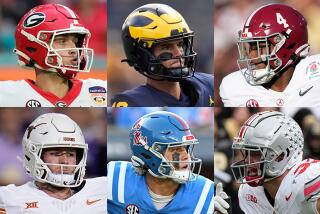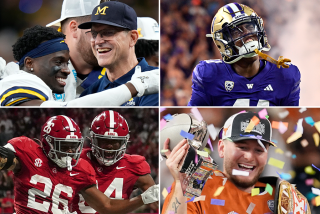Everything but a National Title : Florida State’s Powerful Football Team Seeks Top Billing
- Share via
TALLAHASSEE, Fla. — Florida State brandishes its football team as if forgetful of all those years it was a women’s school. The third-ranked Seminoles have a tom-tom that makes your scalp jump, a jarring war yell and a graveyard where they bury opponents in effigy. If this has an overdone feel to it, it is merely the sort of excess with which the newly rich tend to enjoy their wealth.
The very big business known as Florida State’s football program includes an incorporated booster club, a mirrored shrine for its trophies and a $2.3 million profit from this 10-1 season. Seminole Boosters Inc. is asking for gifts of $28.14 to commemorate FSU’s 28-14 victory over Florida in its regular-season finale. If that doesn’t entice donors, Burt Reynolds can always donate another building.
All the Seminoles need to complete their ever-burgeoning success is a national-championship game. This season they have the next best thing, a Fiesta Bowl meeting against No. 5 Nebraska. They lost to No. 2 Miami by 26-25 this season, and there is considerable sentiment they easily could be playing No. 1 Oklahoma for the national title in the Orange Bowl if not for that loss.
“We’d really rather play Oklahoma,” said Deion Sanders, FSU’s All-American defensive back.
Regardless of that disappointment, this was a season of tremendous wealth and growth at a young football school that is making increasingly consistent progress toward becoming a perennial top-10 team. This marks the fourth time since Coach Bobby Bowden took over in 1976 that the Seminoles have gone 10-1; the third time they have challenged for a national championship but in vain; and their sixth consecutive bowl game.
From 1907 to 1947, Florida State was a liberal arts college for women. As late as 1973, the Seminoles were an 0-11 team. Later, despite Bowden’s huge strides, their reputation as the state’s second college football citizen persisted. Their victory over Florida this season was their first in six years.
“The fact is we’ve got a complex here,” Bowden said. “Florida State was a girls’ school. Anybody who went to school here who is over 65 is a lady. Our alum is not the chairman of the bank, it’s his wife.”
But she’s becoming more influential all the time, if Florida State’s athletic growth is any indication. The school’s athletic budget is $10 million, and the incorporated booster club is rated among the top six in the country. The donating membership is about 12,000, and fund raising has increased from $1 million in 1980 to $4.5 million last year. As an independent, it gets to keep its television and bowl money without having to split it with conference opponents.
It is also one of the more glamorous new college football personalities, a sort of UCLA of the South. Faye Dunaway was a Pi Phi there once. Robert Urich is one of its more successful grads. And Burt Reynolds is so dedicated an alum, he donated a whole football dormitory. Athletic alumni include Dave Cowens, Terry Kennedy, Fred Biletnikoff and the late Dick Howser.
Of Florida’s three preeminent football schools, each has carved out its own personality, and the Seminoles are as charismatic as any. Florida has the old money, tradition and a lingering superiority complex. Miami, in the last decade, has become “the state of Miami,” as Howard Schnellenberger declared it, by virtue of its urban nature. Florida State’s role has become that of the progressive. The school’s younger alumni are just entering their successful years and may seize more and more influence in the state in all areas, not just football.
“Obviously, Florida still has more political power,” said Andy Miller, Seminole Boosters executive director. “But the gap has narrowed. It’s amazing how much of that image is tied up with the football teams.”
The Seminoles also have the good fortune to be situated in a recruiting-rich state. A College Football Assn. survey of all 6,044 active college players this year showed that Florida is the home state of 613 players. Only Texas produced more (866).
Oklahoma’s dominance in the 1980s can be explained in large part by its proximity to Texas. Florida State has the same access to a dominant talent pool.
The result is Bowden has amassed a group of skill players who have been described as among the top three in the country, with Miami’s and Oklahoma’s. For the first time in school history, the Seminoles had two players named All-Americans, Sanders and linebacker Paul McGowan. Their offense was rated No. 2 in the country, behind only Oklahoma, and their defense was rated No. 12.
The numerical increase in talent should prevent the sort of falloff in performance that occurred the last time the Seminoles made a run at a national championship. In 1980, they were just two points away from a title when they built a 10-1 regular-season record marred only by a 10-9 loss to Miami. They went on to the Orange Bowl, where they lost to Oklahoma, 18-17. They finished No. 4. But the next season, their record fell to 6-5. Next year, the Seminoles will have 13 returning starters, including running back Sammie Smith (1,230 yards rushing) and most of the rest of an offense that has averaged 41 points per game this year.
With Florida State’s new talent has come a new attitude. The Seminoles want the arrogant brand of confidence with which Oklahoma, Miami and Nebraska have been tormenting the country for years.
“We’re getting the Oklahoma mentality,” Sanders said. “When you say OU, people immediately know you’re talking about football. It used to be if you said Florida State, you could just as easily be talking about baseball.”
Florida State began this season with the knowledge it was on the verge of something. There was a core of 18 seniors; Bowden instituted new rules and a dress code, and for the first time in memory, all of the Seminoles reported for practice regularly.
“It used to be young guys were missing practice, complaining about things,” leading receiver Herb Gainer said. “The older guys said, ‘These are the coaches’ decisions like it or not, and you better make it work.’ They stopped griping.”
There also was the advent of defense. For the five years after the 1980 Orange Bowl, the Seminoles gave up more than 20 points per game every season, causing them to be labeled all flash and no substance. But in 1984, Bowden hired defensive coordinator Mickey Andrews, who noticed Bowden had a habit of stacking his talent on the offensive side of the ball. Andrews converted some of that talent, including Sanders, who came to Florida State as a wide receiver.
This season, the Seminoles are allowing just 12.3 points and 274 yards a game. Sanders has 4 interceptions, 46 tackles and 9 pass breakups, and McGowan won the Dick Butkus Award on the basis of 150 tackles, 11 for losses.
All of that made the loss to Miami even more painful. The Seminoles held a 19-3 lead in the third quarter, and only a failed last-second pass on a two-point conversion kept them from winning. “A game like that teaches you a lesson,” Sanders said.
The lesson: Florida State still had some growing up to do.
“They were used to winning those games, and we weren’t,” Gainer said. “We knew after that game that if we ever had someone on the ropes again we’d knock them out. Our guys were surprised at being ahead, 19-3. I tried to tell them that we were supposed to be ahead by that much. It should be expected of us.”
If the Seminoles have learned that, this season will prove a most useful one. A Fiesta Bowl victory could get them started on parity with Miami, and Bowden calls that pivotal--particularly after this almost-everything season.
“When you lose you find out about character,” he said. “You’re going up or down, but you’re not going to sit still.”
More to Read
Go beyond the scoreboard
Get the latest on L.A.'s teams in the daily Sports Report newsletter.
You may occasionally receive promotional content from the Los Angeles Times.










